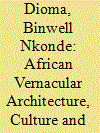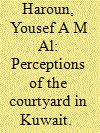| Srl | Item |
| 1 |
ID:
162424


|
|
|
|
|
| Summary/Abstract |
The influence of imported material, technology and methods has put pressure on most traditional architectural systems to modernize. This influence to modernize is transmitted through various mechanisms. This paper argues that there are a number of aspects to vernacular architecture that would be lost through this conversion process to modern materials, technology and methods. Through the examination of vernacular architecture among the Lamba people of Senior Chief Mushili’s chiefdom, the study found that there are cultural, environmental and aesthetical aspects in vernacular architecture that are poorly understood in the process of modernization. Data for this research were collected through an ethnographical approach with occasional in-depth interviews with senior members of the Royal establishment and the community. Thus, the data were mainly qualitative.
|
|
|
|
|
|
|
|
|
|
|
|
|
|
|
|
| 2 |
ID:
172439


|
|
|
|
|
| Summary/Abstract |
The courtyard was once found in every house in Kuwait. It was a multi-purpose open space where the entire family would gather and socialize. Some courtyards had a tree or shrub, and most would have a well. This all changed after the discovery of oil. In the 1950s Kuwait underwent rapid and unprecedented urbanization and within a decade was transformed from a small shaikhdom to a modern regional metropolis. Kuwaitis were forced into a new lifestyle. The Kuwaiti house changed from the courtyard house, sustainable, private and inward-facing, into the modern villa, full of new technology, and facing outward toward the street. In this study, the courtyard is used as a vehicle to examine a number of socio-cultural, economic and political aspects of the move towards modernity in the domestic built environment and away from the vernacular and sustainability. Investigating several questions that have been raised in prior research, this study aims to identify the qualities and uses of the courtyards that people might value and use in the contemporary house. A mixed-method approach has been employed to provide qualitative data to support and complement quantitative findings. The article’s ultimate aim is to add to our understanding of how how people have dealt with and adapted to the collision between traditional concepts and modernity. Among the findings is the existence of a surprising disconnect between past realities and current perceptions, even about what a courtyard is.
|
|
|
|
|
|
|
|
|
|
|
|
|
|
|
|